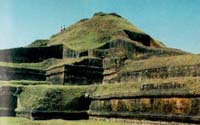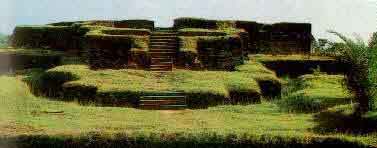Bangladesh India
In The Name Of The People
The ancient, medieval, and colonial history of Bangladesh covers a period from antiquity to 1947, when India was partitioned. So the history of Bangladesh prior to 1947 is a history of India of which Bangladesh was a part. Today it is an independent nation within the Indian subcontinent, but is half the old Bengal or Bangla. For the first civilization of India and later empires go to Ancient India NOVO, 17th July 2000 |
||||||
Ancient History: (NOTE: Bangla, Banga, Bengal will be used interchangably as will Bengali, Bangalee and at times Bangla) Pal Empire
After the end of the Gupta Empire, Sashanka of Gaur (end of 6th and 7th century C.E.) became the first powerful independent Bangla ruler. He was an anti-Buddhist, Shaiva king. His rule extended over all Bangla except maybe Samatat and extended beyond. His empire fell after his son Manav took over. Internal struggles continued and around 648 AD, Shaiva Hindu king BhaskaraVarman, of Kamarupa, conquered PundraVarddhan and Karnasuvarna creating another small empire. And as Bangla was fighting at home, HarshaVardhan of Uttarkhand started to create a large empire. He conquered Magadha defeating PurnaVarman by 641 AD. He conquers Kangoda and Kajangala by 642 AD. Shasanka stops his expansion on the East. In the south he is stopped by the Chalukyas. His empire stretched all over northern India with the exception of the Bengal region. Some historians erroneously put Bengal in his empire as in this map. Further inwards, in Banga, the first Buddhist kings emerged in the 7th century and Samatata became a large Buddhist nation with a few dynasties rising, including the Devas. Samatata was probably under the Banga region of Bengal. There were also some small semi independent Hindu kings in Bengal. Around 647 AD a little known event takes place destabilizing further the region. Buddhist Tibetan kings Srang-tsan-gampo (600-650 AD) and Ki-li-pa-pu (650-679 AD) conquered Magadha and Kamarupa(Assam) and became rulers of much of north India. This weakened the power of North India. After the death of Harshavardhan, rule of Magadha went to his great grandson and three of his descendants. Their rule ends around 725 AD when they are conquered by the Shaila dynasty, a new name in the history pages. The Shailas were probably from the mountains. They occupied Pundra(Western Bengal). Their rule did not last long. The empire of Harsha is called the Harsha empire and is considered the last great Indian empire even though later several great empires are formed. At the time of Harsha, India was basically divided into three major empires. Harsha was in the north, Chalukyas were in the middle and Pallavas in the south. YashoVarman first conquered Magadha and Gaur (Western Bengal) and conquered Banga (Central Bengal) (725-35). But another political power also arose at the time in Kashmir, another old part of the Gupta empire. LalitAditya of Kashmir defeated YashoVarman to expand the Kashmir empire. Then in 748/759 AD Vagadatta king Harsha, king of Kamarupa and father in law of JayaDeva, king of Licchavis conquered Gaur Odra, Kalinga and Koshala. creating another empire. Sometime around this time the Malla dynasty was formed in South West Bengal and lasted for a thousand years until the 16th century. (Mallas ruled Kathmundu Valley 900-1700 AD) Rise of Bangla In 750 AD, in the middle of volatile empires, Gopal became elected as the ruler of Bangla from Gaur. It appears Banga had finally decided to unite to face the others. Gopal Dev was the ruler of B(v)arendra (North Bangla) and not of high caste. However, the Pals are originally from Karnataka, South West India. He established the Pal or Pala empire (8th to 12th century). The Pal emperors cortributed to the establishment of Bangla as a great nation. Gopal ruled 750 to 775 AD consolidating Bangla. His son DharmaPal (ruled 775 to 810 AD) was the Ashok of Bangla. He attempted to expand the empire. He fought with the Pratihara king Vatsa from Gujarat which lies on the west coast of India. Even though he was defeated, fortune was on his side. Rastrakuta (probably Dravir) king Dhruva (ruled 781to 794 AD in the south) rose and defeated both him and Vatsa. Dhurba, however, retreated leaving the north without annexing the land. This allowed DharmaPal to conquer North India. He took Bhoja, Matsya, Madra, Kuru, Yadu, Yavana, Avanti, Gandhara (present day Quandahar in Afganistan) and Kira. He defeated IndraYudha and ChakraYudha of Kanauja. It is then that he probably conquered Nepal which still bears -Pal at the end of its name. He fought over Nepal with Mu-ti-vtsan-po of Tibet. He allowed his conquered teritories a degree of independence and the teritories in return accepted his overlordship. By this he became UttaraPathNath, the lord of the North. Then he was defeated by Nagabhata II, son of Vatsa of Gujarat. However, once again Govinda III of Rastrakuta defeated Nagabhat. DharmaPal accepted the overlordship of Govinda after this. The Rastrakuta's empire extended from Gujarat to tanjore. The Pal empire extended from Bengal to Afganistan. In this way the Pal empire became part of the Rastrakuta empire for a while. They created a lose but large empire through this alliance. DharmaPal's son DevPal (ruled 810 to 847 AD) was also a conqueror. He defeated the Huns, Utkala, Pragjyotisha, Dravid (probably Rastrakuta AmoghaVarsha) and Gurjarat (possibly, Bhojadeva, grandson of Nagabhata). Like DharmaPal he did not attempt to conquer all of India, but only North India. Towards the end of the 9th century the Pal empire underwent decline. Magadha, Anga (Bengal), and Banga (Bengal) was conquered probably by AmoghaVarsha while Rarh was conquered by Orissa. BhojaDeva, Kalachuri, GunambodhiDeva, and Guhilot king Guhila II conquered all North India west of Magadha. Dahala king KokallaDeva I (840-890) looted wealth from Bengal. MahendraPal, son of Bhoja, extended the Pratihara kingdom well into Pundra. Narayan Pal, the Pal emperor managed to only retain Banga (central Bangla) and Bihar but probably went back under the overlordship of the Rastrakutas. Orissa (Varmans) and Kamarupa become powerful next door. And in the 10th century the Pals regain the Magadha but loses it again. Apparently Bangla disintegrated into individual states. Anga, Gaur, Bangala, Rarh etc. Or it could be that central control had just weakened. During this period many smaller kingdoms appeared in Bangla. In the north a Khamboja kingdom appears at Priyangu (location not known. Are they related to the Cambodians?). In the East and South Bengal saw the rise of Harikela under the Devas from Vardhamanapur. In the Tripura region, LahayaChandra rules for a while. In the Dhaka (Central East Bengal) region, the Chandras ruled. The Chandras ruled over the Devas from Chandradwip and later from Bikrampur (Dhaka). The Chandras too have their highs and lows. There was another Chandra dynasty in Arakan (Burma/India) but whether they were related to the Dhaka Chandras is not known. Finally under VigrahaPal's son Mahi Pal I (ruled 977 to 1027), the Pal empire is somewhat reconstituted. It now comprised of East bengal, Tripura region, Anga, and some parts of West Bengal. He suffered defeats at the hands of others but recovered part of the old empire but that ended with his death. His empire did not have the great expanse of his predecessors but maintained a dignified extent. However, his son could not maintain much of the empire. A new group of Mandalikas emerge in Western Bangla at this time as well.
East Bengal was again broken and remained outside the Pal's control. The Sen kindgom once a tributary of the Pals become more powerful aswell. The far eastern part of Bangla sees the rise of Pattikera kingdom (modern day Tripura region). In East Bengal rises the Varmans who came from Kalinga. And there are more conquerors coming to the Magadha-Bengal region. The Senas (Sens) become independent and finally take Bengal from the Pals when Ballal Sen conquered Gaur. The Last Pals rule until 1174 as rulers of Gaya. The Sens ruled 1162-1223 C.E. even though they were in existence much longer since 1095. Both the Pal and the Chandra emperors were Buddhists and in this period Bangla became a centre for buddhism. Under the Pals Bangla reached its high water mark. At the peak, Bangla ruled all north India until Afganistan. The Sen dynasty was Hindu and brought in Brahmins from abroad and made Bangla into Hindu somewhat by force. During the Pal era, Bangla became foremost in learning and culture in the world. It should also be noted that there remained a Pal king in Kabul whose empire consisted of Kapisa on the western side of the Hindu Kush Ranges and Punjab on the Eastern side, much like Ambhi before Alexandre. In 980 AD, Raja Jay Pal Shahi faced Muslim invaders who had taken Gandhar (Quandahar today in Afganistan). These kings were called the Shahi kings and ruled Punjab.
The king of Gazni Sabuktin conquered Kabul. He is famous in Afganistan for his fierce fighting against the Hindus and because he built mosques after destroying Hindu Temples. The main mosque in Kabul is built on the site of a Hindu temple aswell.
|
Pal Empire
Ruins of Nalanda
Paharpur
Moinamoti History of Dances From Gaud (Garh)
|
|||||
| Sources: A Short History Of Bengal by Tanmoy Bhattacharya A Thousand Year Old Bengali Mystic Poetry by Hasna Jasimuddin Moudud, daughter of famous poet Jashimuddin. A History of the Indian People by D. P. Singhal I am indebted to various sources for writing this history ... many books that I have read since I was a kid and those I read now both in paper and on the net. I thank the authors. |Majlish|Kashmir|NOVO1|NOVO2|NOVO3| |ReligionQuest|ArchiveLinks|Ancient| |HOME| |
||||||






